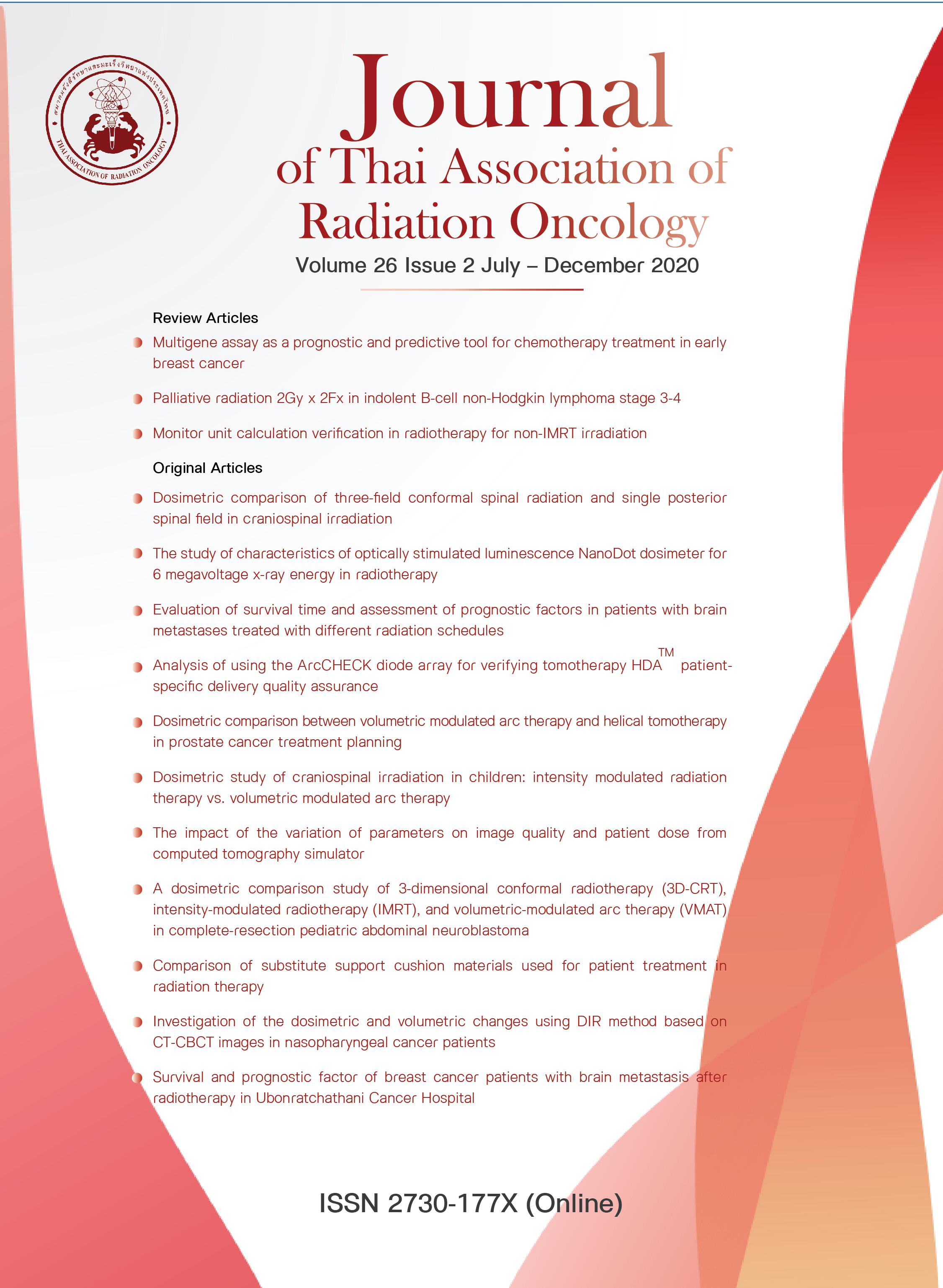Dosimetric comparison of three-field conformal spinal radiation and single posterior spinal field in craniospinal irradiation
Keywords:
3D conformal radiotherapy, craniospinal irradiation, three-field conformal spinal radiationAbstract
Background: Craniospinal irradiation (CSI) is technically challenging because of the need to cover complex clinical target volume. There are innovative techniques improving target volume coverage such as intensity-modulated radiotherapy (IMRT), tomotherapy, and proton therapy. However, 3D conformal radiotherapy (3D-CRT) is still used in limited-resource institutions.
Objectives: To compare the radiation dose to organs at risk (OARs), conformation number (CN), and homogeneity index (HI) between 3-field conformal spinal radiation (3F-SPINE) and single posterior spinal field (1F-SPINE).
Material and methods: From June 2011 to December 2012, 10 patients with high risk of craniospinal involvement underwent CT simulation with supine position and replanned CSI with 3F-SPINE and 1F-SPINE. Prescription dose was 36 Gy to 95% of the PTV. The parameters were V25Gy of heart, V20Gy of lung, mean lung dose, V20Gy of kidneys, mean liver dose, CN, and HI.
Results: 3F-SPINE showed a significant reduction of V25Gy of heart within QUANTEC threshold compared to 1F-SPINE (3.03% vs 42.48%). However, doses to other OARs were within QUANTEC threshold in both techniques. 3F-SPINE showed better results in V20Gy of lung and CN than 1F-SPINE (V20Gy of lung of 9.83% vs 12.59%; and CN of 0.75 vs 0.70, respectively). In contrast, 1F-SPINE showed better results in mean lung dose, V20Gy of kidneys, and HI than 3F-SPINE (mean lung dose of 6.27 Gy vs 8.53 Gy, V20Gy kidneys of 11.24% vs 13.02%, and HI of 1.16 vs 1.17, respectively). There was no significant difference between 3F-SPINE versus 1F-SPINE for mean liver dose (9.03 Gy vs 9.16 Gy).
Conclusion: 3F-SPINE reduced V25Gy of heart to be within QUANTEC threshold. Doses to other OARs were within QUANTEC threshold in both techniques.
References
Parker WA, Freeman CR. A simple technique for craniospinal radiotherapy in the supine position. Radiother Oncol. 2006;78:217-22.
Michalski JM, Klein EE, Gerber R. Method to plan, administer, and verify supine craniospinal irradiation. J Appl Clin Med Phys. 2002;3:310-6.
Seravalli E, Bosman M, Lassen-Ramshad Y, Vestergaard A, Oldenburger F, Visser J, et al. Dosimetric comparison of five different techniques for craniospinal irradiation across 15 European centers: analysis on behalf of the SIOP-E-BTG (radiotherapy working group). Acta Oncol. 2018;57:1240-9.
Brodin NP, Munck Af Rosenschold P, Aznar MC, Kiil-Berthelsen A, Vogelius IR, Nilsson P, et al. Radiobiological risk estimates of adverse events and secondary cancer for proton and photon radiation therapy of pediatric medulloblastoma. Acta Oncol. 2011;50:806-16.
Bentzen SM, Constine LS, Deasy JO, Eisbruch A, Jackson A, Marks LB, et al. Quantitative Analyses of Normal Tissue Effects in the Clinic (QUANTEC): an introduction to the scientific issues. Int J Radiat Oncol Biol Phys. 2010;76:S3-9.
van't Riet A, Mak AC, Moerland MA, Elders LH, van der Zee W. A conformation number to quantify the degree of conformality in brachytherapy and external beam irradiation: application to the prostate. Int J Radiat Oncol Biol Phys. 1997;37:731-6.
Tongwan D, Peerawong T, Oonsiri S, Shotelersuk K. Craniospinal irradiation in the supine position: a dosimetric analysis. Asian Biomedicine. 2009;3:699-708.
Tatcher M, Glicksman AS. Field matching considerations in craniospinal irradiation. Int J Radiat Oncol Biol Phys. 1989;17:865-9.
Tinkler SD, Lucraft HH. Are moving junctions in craniospinal irradiation for medulloblastoma really necessary? Br J Radiol. 1995;68:736-9.
Sharma DS, Gupta T, Jalali R, Master Z, Phurailatpam RD, Sarin R. High-precision radiotherapy for craniospinal irradiation: evaluation of three-dimensional conformal radiotherapy, intensity-modulated radiation therapy and helical TomoTherapy. Br J Radiol. 2009;82:1000-9.
Downloads
Published
How to Cite
Issue
Section
License
บทความที่ได้รับการตีพิมพ์เป็นลิขสิทธิ์ของวารสารมะเร็งวิวัฒน์ ข้อความที่ปรากฏในบทความแต่ละเรื่องในวารสารวิชาการเล่มนี้เป็นความคิดเห็นส่วนตัวของผู้เขียนแต่ละท่านไม่เกี่ยวข้องกับ และบุคคลากรท่านอื่น ๆ ใน สมาคมฯ แต่อย่างใด ความรับผิดชอบองค์ประกอบทั้งหมดของบทความแต่ละเรื่องเป็นของผู้เขียนแต่ละท่าน หากมีความผิดพลาดใดๆ ผู้เขียนแต่ละท่านจะรับผิดชอบบทความของตนเองแต่ผู้เดียว




